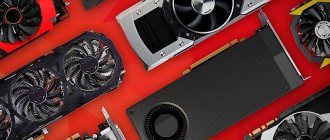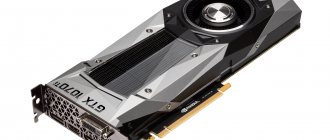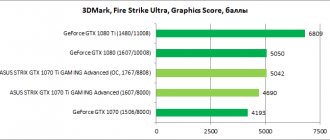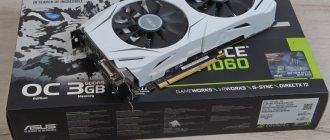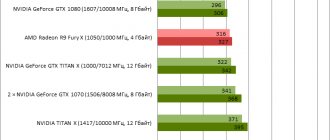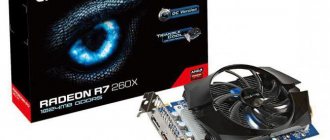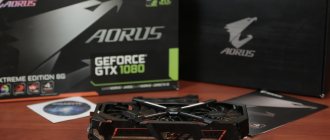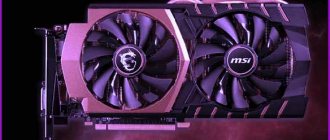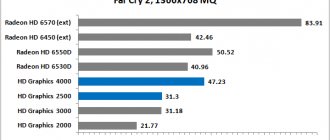AMD Radeon RX 480 8Gb.
Version from HIS With the advent of the new gaming video card RX 480, most gamers are thinking about upgrading their PC, this is not surprising because such performance at this price point has not been seen for a long time. AMD has released two solutions, the RX 480 4GB which costs $199 and the RX 480 8GB which will cost you $40 more, let's decide if it's worth it and whether the difference in memory sizes is a significant difference.
Radeon RX 480 Specifications
As practice shows, 4 and 8 GB are practically no different, but the memory of the 8Gb version is faster - 256 GB/sec, and its younger model has 224 GB/sec.
Now looking at the tests:
You can understand that the $199 version loses a little, showing results that are 3-4% worse than the $240 video card in each test. But these percentages clearly do not justify the premium, because when the video card is running you are unlikely to feel these minor differences, and if you look at the system requirements of modern games, you can understand that 4GB is enough.
RX 480 4Gb – Unigine Heaven – Haswell
RX 480 4Gb – Unigine Valley – Skylake
RX 480 4Gb – Unigine Heaven – Skylake
RX 480 4Gb – Unigine Valley – Haswell
Now let's move on to the 8GB version. I would like to say that the clock frequency is limited to 1266 MHz, but this is not the limit of the chip, which is created using 14 FiNFER technology. AMD themselves assure that the transition between nodes from 28 nm to 14 nm increased the performance of the video card by 1.8 times, and as for optimization, it was brought to a ratio of 2.9. And a comparison with the GeForce GTX 1070 immediately comes to mind, which with the same power and a slightly more capacious GPU reaches a frequency of 1683 MHz.
Let's talk briefly about the characteristics of the RX 480:
- Architecture - GCN 4th generation.
- The number of computational units is 36.
- Threaded processes – 2304.
- Clock frequencies. Basic and boost – 1120 MHz / 1266 MHz.
- Peak performance reaches up to 5.8 teraflops.
- Memory type – GDDR
- Memory bandwidth is 224 GB and sometimes higher.
- Standard board consumption is 150 W.
- HDMI cable version is 2.0.
- The maximum resolution is 5120x2880.
- Video memory capacity - 8192 MB.
- Interface – PCI-E 16x 3.0
There is support for Directx 12, as well as the new Polaris architecture with AMD LiquidVR technology, providing a feeling of deep realism when combined with immersive VR headsets.
Manufacturers and tests
ASUS
ASUS offers two designs for the RX 480, the first being its own design designed for ROG STRIX adapters. And Asus Rog Strix-Rx480-O8g-Gaming with a factory overclocking frequency of 1330 MHz. The video card has 8 GB of GDDR5 memory, operating at a frequency of 8000 MHz. The video card implements a hybrid mode of operation of the cooling system, which means that in idle mode the RX 480 is silent.
The radiator is enough to maintain the GPU temperature at 40-50 degrees. When testing the video card, its peak temperature did not exceed 70 degrees, in order to prevent the chip from heating up more strongly, the fans were spinning at speeds above 2000 rpm. Also, thanks to utilities, you can configure your cooling mode, but without the appropriate knowledge you should not do this.
Testing
- Unigine Valley Benchmark - FPS: 53, Score 2228.
- Unigine Heaven Benchmark - FPS: 52, Score 1313.
- Benchmark Sky Diver – graphics score 4043
Game tests:
The extension in all games was set to 1920x1080, and VSync functions were disabled, all other settings were set to maximum. Intel Core i7-7700K processor with a frequency of 4.2GHz.
And here are the results we got:
- Crysis 3 – 52 Fps.
- DOOM - 67 Fps.
- Dying Light: - The Following 42 Fps.
- GTA5 - 47 Fps.
From these data we can conclude that the RX 480 is perfect for gamers, and provides them with good immersion without brakes.
Sapphire
Sapphire Radeon RX 480 Nitro+ 8Gb – Sapphire has several imperfect models based on the Polaris 10 architecture. Created on the basis of the Nitro base, they combined high-quality use of the element base and a non-reference cooling system, which later provided these video cards with high performance, as well as low noise level, as well as a rich set of functionality. The model 480 was equipped with a DualX cooler with new Quick Connect technology, this technology allows for quick replacement of the fan, which allows cleaning several times faster, just as the TriXX utility is installed, it is responsible for the performance of your cooler, according to the developer, if your cooler is broken, then By contacting support, they can send you a replacement.
Testing
The Sapphire Radeon RX 480 Nitro+ 8Gb receives an insignificant factory overclock, but considering its competitors, this is a step forward. The frequency increases from 1120 MHz to 1160 MHz and in boost mode from 1266 to 1306. I would also like to note that in the mode when the video card is not loaded, the system slows down the fans and the temperature remains at 40-45 degrees, this reduces energy costs. To evaluate the performance, 3DMark Fire Strike was used; as a result of testing, the RX 480 Nitro+ 8Gb showed itself to perform quite well, the chip frequency was 1250-1285 MHz, while the fans operated at only 39% of their peak power. The video card itself worked quietly during the test, and its temperature was 75-76 degrees.
- Unigine Valley Benchmark - FPS: 54, Score 2265.
- Unigine Heaven Benchmark - FPS: 53, Score 1358.
- Benchmark Fire Strike – graphics score 13163.
In gaming tests:
Intel Core i7-7700K processor with a frequency of 4.2GHz.
- Crysis 3, Textures: Max, MSAAx8, 1920x1080 – stable 55 fps, although there were drops to 40, at moments when there were too many explosions.
- The Witcher 3: Wild Hunt, High settings, HairWorks off, 1920x1080 – fps values ranged from 50 to 90 in places with different congestion such as cities. We conclude that it is quite playable.
- Rise Of Tomb Rider: 1920×1080 High graphics settings – the game shows an average value of 41 fps, which is also quite enough for a comfortable game.
Gigabyte
Summer 2020, it was at this moment that AMD Polaris graphics chips were released. Which became the first step for Gigabyte in the transition to 14 nm chips, and after that new opportunities opened up for them; the RX 480, RX 470 series models built on this basis became the driving force of production in the mid-price segment.
Testing
As tests have shown, video cards with alternative cooling systems are greatly influenced by clock speeds and temperatures. The RX 480 is equipped with a WindForse cooler that can cope with temperatures up to 78 degrees, of course this is not the lowest level, but let’s be honest, it’s not the highest. It is important that the temperature does not exceed a critical value, otherwise the video card may burn out.
- Unigine Valley Benchmark - FPS: 56, Score 2285.
- Unigine Heaven Benchmark - FPS: 50, Score 1318.
- Benchmark Fire Strike – graphics score 14163.
In gaming tests:
Expansion in all games 1920x1080, best quality settings, all tests in DirectX 11: Intel Core i7-7700K processor with a frequency of 4.2GHz.
- Rise Of the Tomb Raider – 45 Fps.
- Fallout 4 – 45 Fps.
- The Witcher 3: Wild Hunt - 50 Fps.
- BattleField 1 – 40 Fps.
Review and testing of the AMD Radeon RX 480 video card
Table of contents
- Introduction
- New opportunities
- Specifications
- AMD Radeon RX 480 review
- Appearance and dimensions
- Printed circuit board
- Cooling system
- Star Wars Battlefront
- Battlefield 4
- The Witcher 3: Wild Hunt
- Sniper Elite III
- Fallout 4
- Hitman (2016)
- Ashes of the Singularity
- Grand Theft Auto V
- Tom Clancy's The Division
- Rise of the Tomb Raider
- 3DMark
Introduction
It’s very difficult to write an introduction when you already know the results and it’s too early to share them. So I'll start from afar. Since the introduction of the GCN architecture, AMD has set the bar high for its competitors.
Unfortunately, over time, solutions based on GCN, although they received new revisions, began to lag behind. At this time, Nvidia managed to recover from two diseases: it made a breakthrough in reducing the power consumption of video cards and significantly increased frequencies by introducing smart GPU Boost control algorithms.
AMD has been waiting for the right opportunity, and now it has arrived. In one fell swoop, the manufacturer released a video card offered at an affordable price, the GPU of which reached a frequency of 1.25 GHz (previous reference frequencies were about 1.0 GHz), equipped it with 8 GB of video memory operating at a frequency of 8 GHz, and lowered the power consumption bar from 200-250 to 150 W .
announcements and advertising
2080 Super Gigabyte Gaming OC for 60 rubles.
Compeo.ru - the right comp store without any tricks
RTX 2060 becomes cheaper before the arrival of 3xxx
Ryzen 4000
series included in computers already in Citylink
The price of MSI RTX 2070 has collapsed after the announcement of RTX 3xxx
Core i9 10 series is half the price of the same 9 series
The price of memory has been halved in Regard - it’s more expensive everywhere
New opportunities
When developing a new graphics solution, AMD paid attention to several areas at once. Among them:
- The multiGPU (Crossfire) standard has become open (GPUopen);
- Introduction of XConnect support for connecting video cards in an external box;
- AMD LiquidVR API standard for multi-resolution rendering for VR;
- Increased buffers and optimization of shader instruction prefetching;
- Asynchronous computing (prioritization and pre-scheduling);
- Hardware support for 4K60 HEVC codec and H.265 Main 10 decoding;
- Support for HDR monitors.
There are fewer changes in architecture. The main scalability problem of previous versions of GCN was the low specific load of execution units. Because of this, efficiency suffered when part of the GPU was idle without work.
GCN 1.4 should remove almost all bottlenecks. To achieve this, a number of important details have been updated:
- Instruction caching has improved;
- Improved prefetching of shader instructions;
- Improved performance in single-threaded tasks;
- It is now possible to group requests in the L2 cache;
- Cache response time has decreased;
- The total performance per CU unit has increased to 15% compared to GCN 1.0;
- Updated memory controller;
- More efficient texture compression methods;
- The volume of L2 cache memory has doubled;
- Hardware scheduler for asynchronous computing.
The GPU has new sensors and frequency control circuits and CUs. They take into account the power consumption and temperature of individual video core blocks and, based on this data, control the frequency of the entire GPU.
According to AMD, thanks to this method it is possible to increase the effective frequency by 15-20% within a certain power consumption. Together, the 14 nm process technology and the initial focus on reducing power consumption when developing GPUs resulted in an almost threefold improvement in speed/power consumption compared to GCN 1.0.
Specifications
| Name | Radeon R9 380X | Radeon R9 390 | Radeon RX 480 | GeForce GTX 960 |
| Codename | Tonga | Hawaii | Polaris | GM206 |
| Version | GCN 1.2 | GCN 1.1 | GCN 1.4 | Maxwell 2.x |
| Technical process, nm | 28 | 28 | 14 | 28 |
| Size of core/cores, mm2 | 366 | 438 | 232 | 227 |
| Number of transistors, million | 5000 | 6200 | ??? | 2940 |
| Core frequency, MHz | – | – | 1220 | 1126 |
| Core frequency (Turbo), MHz | 970 | 1000 | 1266 | 1178 |
| Number of shaders (PS), pcs. | 2048 | 2560 | 2304 | 1024 |
| Number of texture units (TMU), pcs. | 128 | 160 | 144 | 64 |
| Number of rasterization units (ROP), pcs. | 32 | 64 | 32 | 32 |
| Maximum fill rate, Gpix/s | 31 | 64 | 40.5 | 36 |
| Maximum texture sampling speed, Gtex/s | 124 | 160 | 182 | 72.1 |
| Memory type | GDDR5 | GDDR5 | GDDR5 | GDDR5 |
| Effective memory frequency, MHz | 1425 | 1500 | 2000 | 1750 |
| Memory capacity, GB | 4 | 8 | 8 | 2 |
| Memory bus, bit | 256 | 512 | 256 | 128 |
| Memory bandwidth, GB/s | 182 | 384 | 256 | 112.2 |
| Power, Pin connectors | 6 + 6 | 6 + 8 | 6 | 6 |
| Power consumption (2D/3D), Watt | -/190 | -/275 | -/150 | -/120 |
| CrossFire/Sli | V | V | V | V |
| Announcement price, $ | 229 | 329 | 229 | 200 |
| Replacement model | Radeon R9 280X | Radeon R9 290 | Radeon R9 380(X) | GeForce GTX 760 |
The closest competing solutions for the AMD Radeon RX 480 in price will be the GeForce GTX 960 video cards for $200 and the Radeon R9 380X with a recommended price at the time of the announcement of $229.
